62392-6
PhenX - blood pressure protocol 040301
Trial
Status Information
- Status
- TRIAL
Term Description
A measure to assess a respondent's systolic and diastolic blood pressure, which is used to determine high blood pressure (hypertension). Assessment must also include measures for personal history of high blood pressure and a history of medication usage. Ask questions "1" and "2," and then proceed to the protocol for obtaining blood pressure. The use of high blood pressure medications must be obtained.
Reference Information
| Type | Source | Reference |
|---|---|---|
| Image | Consensus measures for Phenotypes and Exposures | Locate the brachial artery by palpation and mark the skin with a small dot, using a black pen. (The brachial artery is usually found just medial and superior to the cubital fossa, posterior to the biceps muscle and slightly toward the body.)
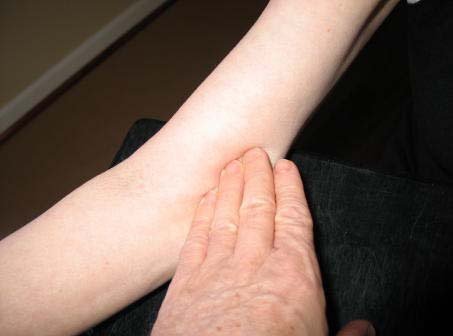 |
| Image | Consensus measures for Phenotypes and Exposures | Push START button on the monitor and wait for the output
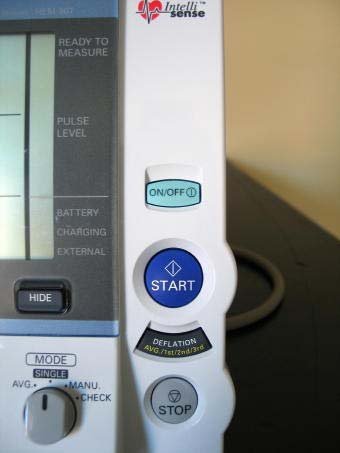 |
| Image | Consensus measures for Phenotypes and Exposures | For cuff sizes small, medium and large, connect the air tube to the main unit by attaching the air plug to the base of the air connector.
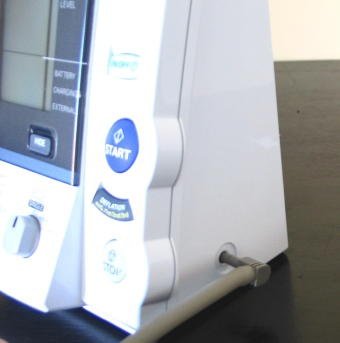 |
| Image | Consensus measures for Phenotypes and Exposures | Set P-Set Dial to AUTO
 |
| Image | Consensus measures for Phenotypes and Exposures | Set Mode to SINGLE
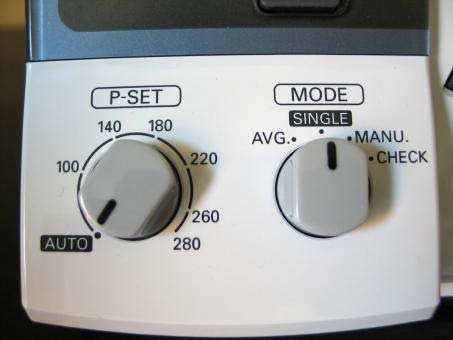 |
| Image | Consensus measures for Phenotypes and Exposures | Blood Pressure Unit
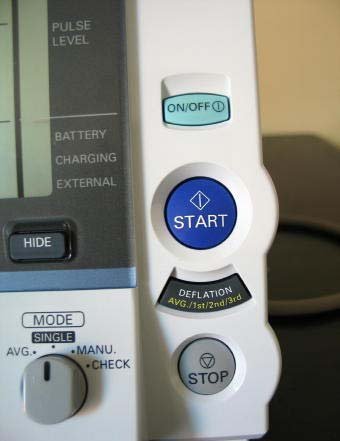 |
| Image | Consensus measures for Phenotypes and Exposures | Turn the ON/OFF button to ON.
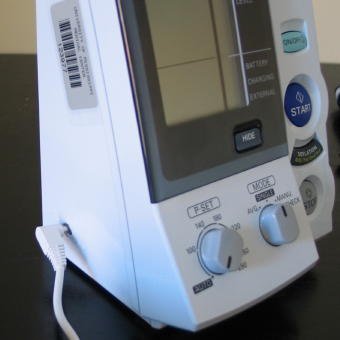 |
| Image | Consensus measures for Phenotypes and Exposures | Place the appropriate cuff around the upper right arm so that the midpoint of the length of the bladder lies over the brachial artery.
The cubital fossa is at heart level.
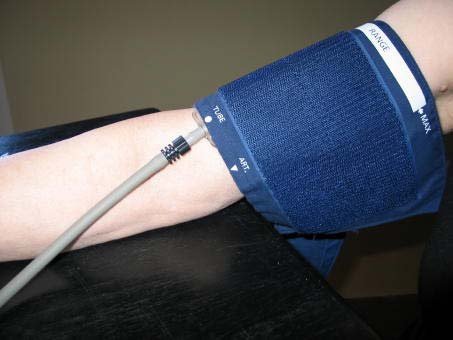 |
| Image | Consensus measures for Phenotypes and Exposures | Ensure the participant is seated, legs uncrossed, in a quiet room, with the elbow and forearm resting comfortably on the armrest of the BP measurement chair (or table), with the palm of the hand turned upward
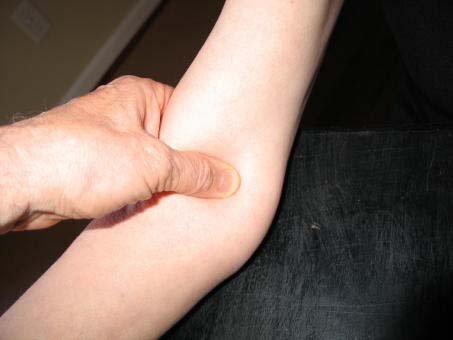 |
| Citation | Consensus measures for Phenotypes and Exposures | U.S. Department of Health and Human Services. National Institutes of Health. National Heart, Lung and Blood Institute and Boston University. Framingham Heart Study (FHS). Generation 3. Exam 1. Medical History-Medications. Page 23. No question number provided (source for question 2 in Protocol Text). |
| Image | Consensus measures for Phenotypes and Exposures | Cuff size indicated by measured arm circumference
 |
| Article | Consensus measures for Phenotypes and Exposures | O'Brien, E., Pickering, T., Asmar, R., Myers, M., Parati, G., Staessen, J., Mengden, T., Imai, Y., Waeber, B., Palatini, P., Atkins, N., & Gerin, W.; the Working Group on Blood Pressure Monitoring of the European Society of Hypertension. (2002). International protocol for validation of blood pressure measuring devices in adults. Blood Pressure Monitoring, 7, 3-17. Retrieved on July 21, 2009, from http://www.dableducational.org/pdfs/International%20Protocol%202002.pdf |
| Citation | Consensus measures for Phenotypes and Exposures | Association for the Advancement of Medical Instrumentation. American National Standard. Manual, electronic or automated sphygmomanometers ANSI/AAMI SP10-2002/A1. 3330 Washington Boulevard, Suite 400, Arlington, VA 22201-4598, USA: AAMI; 2003. |
| Article | Consensus measures for Phenotypes and Exposures | O'Brien, E., Petrie, J., Littler, W. A., de Swiet, M., Padfield, P. L., Altman, D., Bland, M., Coats, A., & Atkins, N. (1993). The British Hypertension Society protocol for the evaluation of blood pressure measuring devices. Journal of Hypertension, 11(2), S43-S62. |
| Article | Consensus measures for Phenotypes and Exposures | Chobanian, A. V., Bakris, G. L., Black, H. R., Cushman, W. C., Green, L. A., Izzo, J. L., Jr., Jones, D. W., Materson, B. J., Oparil, S., Wright, J. T., Jr., & Roccella, E. J.; National Heart, Lung and Blood Institute Committee on Prevention, Detection, Evaluation and Treatment of High Blood Pressure; National High Blood Pressure Education Program Coordinating Committee. (2003). The Seventh Report of the Joint National Committee on Prevention, Detection, Evaluation and Treatment of High Blood Pressure: The JNC 7 report. Journal of the American Medical Association, 289, 2560-2572. Retrieved July 16, 2009, from http://www.nhlbi.nih.gov/guidelines/hypertension/jnc7full.pdf (source for Diagnostic Criteria). |
| Citation | Consensus measures for Phenotypes and Exposures | U.S. Department of Health and Human Services. National Institutes of Health. National Heart, Lung and Blood Institute. Coronary Artery Risk Development in Young Adults (CARDIA) Study. Year 20 (2005-2006) Manual of Operations. Section 3-Blood Pressure and Pulse (source for question 3). |
| Citation | Consensus measures for Phenotypes and Exposures | U.S. Department of Health and Human Services. National Institutes of Health. National Heart, Lung and Blood Institute. Coronary Artery Risk Development in Young Adults (CARDIA) Study. Y20 CARDIA VII. Medical History Form. Page 1. Question 1 (source for question 1). |
Panel Hierarchy
Details for each LOINC in Panel LHC-Forms
| LOINC | Name | R/O/C | Cardinality | Example UCUM Units |
|---|---|---|---|---|
| 62392-6 | PhenX - blood pressure protocol 040301 | |||
| Indent58295-7 | Has a doctor or nurse ever said that you have High blood pressure or hypertension? | |||
| Indent58296-5 | If Yes, at what age? | a | ||
| Indent58297-3 | For women, Was this diagnosis during pregnancy only? | |||
| Indent58298-1 | Have you ever taken medication for hypertension/high blood pressure? | |||
| Indent58294-0 | If yes, At what age did you begin taking medicine for this? | a |
Fully-Specified Name
- Component
- PhenX - blood pressure protocol 040301
- Property
- -
- Time
- Pt
- System
- ^Patient
- Scale
- -
- Method
- PhenX
Additional Names
- Long Common Name
- PhenX - blood pressure protocol 040301
- Short Name
- Blood pressure proto
Survey Question
- Source
- PX040301
Basic Attributes
- Class
- PANEL.PHENX
- Type
- Clinical
- First Released
- Version 2.36
- Last Updated
- Version 2.66 (NAM)
- Change Reason
- Updated the PhenX ID from "PhenX.<ID>" to "PX<ID>" in Survey Question Source field to align with the variable identifier used in the PhenX Toolkit.; Added the PhenX protocol ID to the Component to clearly define the protocol version for which this panel is based upon.
- Panel Type
- Panel
Language Variants Get Info
| Tag | Language | Translation |
|---|---|---|
| el-GR | Greek (Greece) | PhenX - πρωτόκολλο αρτηριακής πίεσης 040301: Synonyms: PhenX - πρωτόκολλο αρτηριακής πίεσης 040301 Αίμα Αρτηριακή πίεση Πίεση |
| es-MX | Spanish (Mexico) | PhenX - protocolo de presión arterial 040301: |
| it-IT | Italian (Italy) | PhenX - pressione sanguigna, protocollo: Synonyms: Panel PhenX paziente PhenX PhenX - pressione arteriosa, protocollo Punto nel tempo (episodio) |
| ru-RU | Russian (Russian Federation) | PhenX - артериальное давление протокол: Synonyms: Точка во времени; |
| zh-CN | Chinese (China) | PhenX - 血压方案 040301: Synonyms: Consensus measures for Phenotypes and eXposures; |
LOINC Terminology Service (API) using HL7® FHIR® Get Info
Requests to this service require a free LOINC username and password. Below is a sample of the possible capabilities. See the LOINC Terminology Service documentation for more information.
- CodeSystem lookup
- https:
//fhir.loinc.org/CodeSystem/$lookup?system=http: //loinc.org&code=62392-6 - Questionnaire definition
- https:
//fhir.loinc.org/Questionnaire/?url=http: //loinc.org/q/62392-6
LOINC Copyright
Copyright © 2025 Regenstrief Institute, Inc. All Rights Reserved. To the extent included herein, the LOINC table and LOINC codes are copyright © Regenstrief Institute, Inc. and the Logical Observation Identifiers Names and Codes (LOINC) Committee. See https://